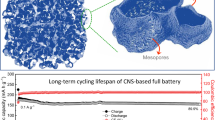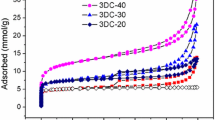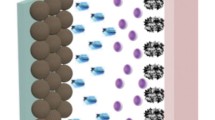Abstract
Using an improved single-step hydrothermal method, mesoporous hard carbon nano-balls, with nitrogen doping, have been successfully synthesized. These materials exhibit good reversible charge capacity during half-cell tests. Gravimetric capacity for undoped nano-sized and micron-sized mesoporous hard carbon balls is 506 and 475 mAh g−1, respectively. After nitrogen doping, the specific gravimetric capacities of both nano- and micron-sized carbon balls increase by 6.9 and 8%, respectively. Nitrogen doping enhances retention in specific capacity of both anode materials, particularly in nano-sized carbon balls with capacity retention of 83.9% after 100 cycles. The enhancement is attributed to a significant decrease in volume expansion due to the nitrogen doping. Density functional theory-based computation confirms the reduction of volume expansion by 60%. Improved electrochemical performance of nitrogen-doped hard carbon is due to the drop in volume expansion rate during lithiation along with increased porosity and electronic conductivity. Furthermore, this one-step synthesis can be extended to other carbon sources to get nitrogen-doped hard carbon with sizes varying from micro to nano.










Similar content being viewed by others
References
Wu YP, Rahm E, Holze R (2003) Carbon anode materials for lithium ion batteries. J Power Sources 114:228–236
Iijima T, Suzuki K, Matsuda Y (1995) Electrodic characteristics of various carbon materials for lithium rechargeable batteries. Synth Met 73:9–20
Candelaria SL, Shao Y, Zhou W et al (2012) Nanostructured carbon for energy storage and conversion. Nano Energy 1:195–220
Pollet BG, Staffell I, Shang JL (2012) Current status of hybrid, battery and fuel cell electric vehicles: From electrochemistry to market prospects. Electrochim Acta 84:235–249
Dahn JR, Zheng T, Liu Y, Xue JS (1995) Mechanisms for lithium insertion in carbonaceous materials. Science (80- ) 270:590–593
Yi J, Li XP, Hu SJ et al (2011) Preparation of hierarchical porous carbon and its rate performance as anode of lithium ion battery. J Power Sources 196:6670–6675
Hu B, Wang K, Wu L et al (2010) Engineering carbon materials from the hydrothermal carbonization process of biomass. Adv Mater 22:813–828
Fang Y, Gu D, Zou Y et al (2010) A low-concentration hydrothermal synthesis of biocompatible ordered mesoporous carbon nanospheres with tunable and uniform size. Angew Chem Int Ed 49:7987–7991
Courtel FM, Niketic S, Duguay D et al (2011) Water-soluble binders for MCMB carbon anodes for lithium-ion batteries. J Power Sources 196:2128–2134
Wang Q (2002) Novel spherical microporous carbon as anode material for Li-ion batteries. Solid State Ionics 152–153:43–50
Wang Q, Li H, Chen L, Huang X (2001) Monodispersed hard carbon spherules with uniform nanopores. Carbon N Y 39:2211–2214
Luo C, Xu Y, Zhu Y et al (2013) Selenium@ Mesoporous Carbon Composite with Superior Lithium and Sodium Storage Capacity. ACS Nano:8003–8010
Hu YS, Adelhelm P, Smarsly BM et al (2007) Synthesis of hierarchically porous carbon monoliths with highly ordered microstructure and their application in rechargeable lithium batteries with high-rate capability. Adv Funct Mater 17:1873–1878
Geng D, Yang S, Zhang Y et al (2011) Nitrogen doping effects on the structure of graphene. Appl Surf Sci 257:9193–9198
Ma C, Shao X, Cao D (2012) Nitrogen-doped graphene nanosheets as anode materials for lithium ion batteries: a first-principles study. J Mater Chem 22:8911
Ismagilov ZR, Shalagina AE, Podyacheva OY et al (2009) Structure and electrical conductivity of nitrogen-doped carbon nanofibers. Carbon N Y 47:1922–1929
Han P, Yue Y, Zhang L et al (2011) Nitrogen-doping of chemically reduced mesocarbon microbead oxide for the improved performance of lithium ion batteries. Carbon N Y 50:1355–1362
Liu H, Jia M, Sun N et al (2015) Nitrogen-Rich Mesoporous Carbon as Anode Material for High-Performance Sodium-Ion Batteries. ACS Appl Mater Interfaces 7:27124–27130
Cao B, Liu H, Xu B et al (2016) Mesoporous soft carbon as an anode material for sodium ion batteries with superior rate and cycling performance. J Mater Chem A 4:6472–6478
Cao B, Liu H, Xing Z et al (2015) Preparation of Nitrogen-Doped Carbon Spheres by Injecting Pyrolysis of Pyridine. ACS Sustain Chem Eng 3:1786–1793
Liu H, Jia M, Cao B et al (2016) Nitrogen-doped carbon / graphene hybrid anode material for sodium- ion batteries with excellent rate capability. J Power Sources 319:195–201
Li X, Liu J, Zhang Y et al (2012) High concentration nitrogen doped carbon nanotube anodes with superior Li+ storage performance for lithium rechargeable battery application. J Power Sources 197:238–245
Li X, Geng D, Zhang Y et al (2011) Superior cycle stability of nitrogen-doped graphene nanosheets as anodes for lithium ion batteries. Electrochem Commun 13:822–825
Ren W, Li DJ, Liu H et al (2013) Lithium storage performance of carbon nanotubes with different nitrogen contents as anodes in lithium ions batteries. Electrochim Acta 105:75–82
Qie L, Chen WM, Wang ZH et al (2012) Nitrogen-doped porous carbon nanofiber webs as anodes for lithium ion batteries with a superhigh capacity and rate capability. Adv Mater 24:2047–2050
Chen T, Pan L, Loh TAJ et al (2014) Porous nitrogen-doped carbon microspheres as anode materials for lithium ion batteries. Dalton Trans 43:14931–14935
Hu T, Sun X, Sun H et al (2014) Rapid synthesis of nitrogen-doped graphene for a lithium ion battery anode with excellent rate performance and super-long cyclic stability. Phys Chem Chem Phys 16:1060–1066
Mao Y, Duan H, Xu B et al (2012) Lithium storage in nitrogen-rich mesoporous carbon materials. Energy Environ Sci 5:7950
Cai D, Wang S, Lian P et al (2013) Superhigh capacity and rate capability of high-level nitrogen-doped graphene sheets as anode materials for lithium-ion batteries. Electrochim Acta 90:492–497
Gong Y, Wei Z, Wang J et al (2014) Design and Fabrication of Hierarchically Porous Carbon with a Template-free Method. Sci Rep 4:6349
Latham KG, Jambu G, Joseph SD, Donne SW (2014) Nitrogen Doping of Hydrochars Produced Hydrothermal Treatment of Sucrose in H 2 O, H 2 SO 4 , and NaOH. ACS Sustain Chem Eng 2:755–764
Marks N (1997) Evidence for subpicosecond thermal spikes in the formation of tetrahedral amorphous carbon. Phys Rev B 56:2441–2446
Plimpton S (1995) Fast Parallel Algorithms for Short-Range Molecular Dynamics. J Comput Phys 117:1–19
Brenner DW, Shenderova OA, Harrison JA et al (2002) A second-generation reactive empirical bond order (REBO) potential energy expression for hydrocarbons. J Phys Condens Matter 14:783–802
Kresse G, Hafner J (1993) Ab initio molecular dynamics for liquid metals. Phys Rev B 47:558–561
Kresse G, Furthmüller J (1996) Efficient iterative schemes for ab initio total-energy calculations using a plane-wave basis set. Phys Rev B 54:11169–11186
Grimme S (2006) Semiempirical GGA-type density functional constructed with a long-range dispersion correction. J Comput Chem 27:1787–1799
Monkhorst H, Pack J (1976) Special points for Brillouin zone integrations. Phys Rev B 13:5188–5192
Bhattacharjya D, Park H-Y, Kim M-S et al (2014) Nitrogen-doped carbon nanoparticles by flame synthesis as anode material for rechargeable lithium-ion batteries. Langmuir 30:318–324
Nemanich RJ, Solin SA (1979) First- and second-order Raman scattering from finite-size crystals of graphite. Phys Rev B 20:392–401
Kundu S, Wang Y, Xia W, Muhler M (2008) Thermal Stability and Reducibility of Oxygen-Containing Functional Groups on Multiwalled Carbon Nanotube Surfaces: A Quantitative High-Resolution XPS and TPD/TPR Study. J Phys Chem C 112:16869–16878
Burg P, Fydrych P, Cagniant D et al (2002) The characterization of nitrogen-enriched activated carbons by IR, XPS and LSER methods. Carbon N Y 40:1521–1531
Mao Y, Duan H, Xu B et al (2012) Lithium storage in nitrogen-rich mesoporous carbon materials. Energy Environ Sci 5:7950
Kapteijn F, Moulijn JA, Matzner S, Boehm H-P (1999) The development of nitrogen functionality in model chars during gasification in CO2 and O2. Carbon N Y 37:1143–1150
Tang K, White RJ, Mu X et al (2012) Hollow carbon nanospheres with a high rate capability for lithium-based batteries. ChemSusChem 5:400–403
Han YJ, Chung D, Nakabayashi K et al (2016) Effect of heat pre-treatment conditions on the electrochemical properties of mangrove wood-derived hard carbon as an effective anode material for lithium-ion batteries. Electrochim Acta 213:432–438
Zheng F, Yang Y, Chen Q (2014) High lithium anodic performance of highly nitrogen-doped porous carbon prepared from a metal-organic framework. Nat Commun 5:5261
Qi Y, Guo H, Hector LG, Timmons A (2010) Threefold Increase in the Young’s Modulus of Graphite Negative Electrode during Lithium Intercalation. J Electrochem Soc 157:A558
Acknowledgements
The authors acknowledge their affiliated institution, Indian Institute of Technology Kharagpur, West Bengal, India, for providing the research facilities.
Author information
Authors and Affiliations
Corresponding author
Rights and permissions
About this article
Cite this article
Agrawal, A., Biswas, K., Srivastava, S.K. et al. Effect of N-doping on hard carbon nano-balls as anode for Li-ion battery: improved hydrothermal synthesis and volume expansion study. J Solid State Electrochem 22, 3443–3455 (2018). https://doi.org/10.1007/s10008-018-4044-6
Received:
Revised:
Accepted:
Published:
Issue Date:
DOI: https://doi.org/10.1007/s10008-018-4044-6




